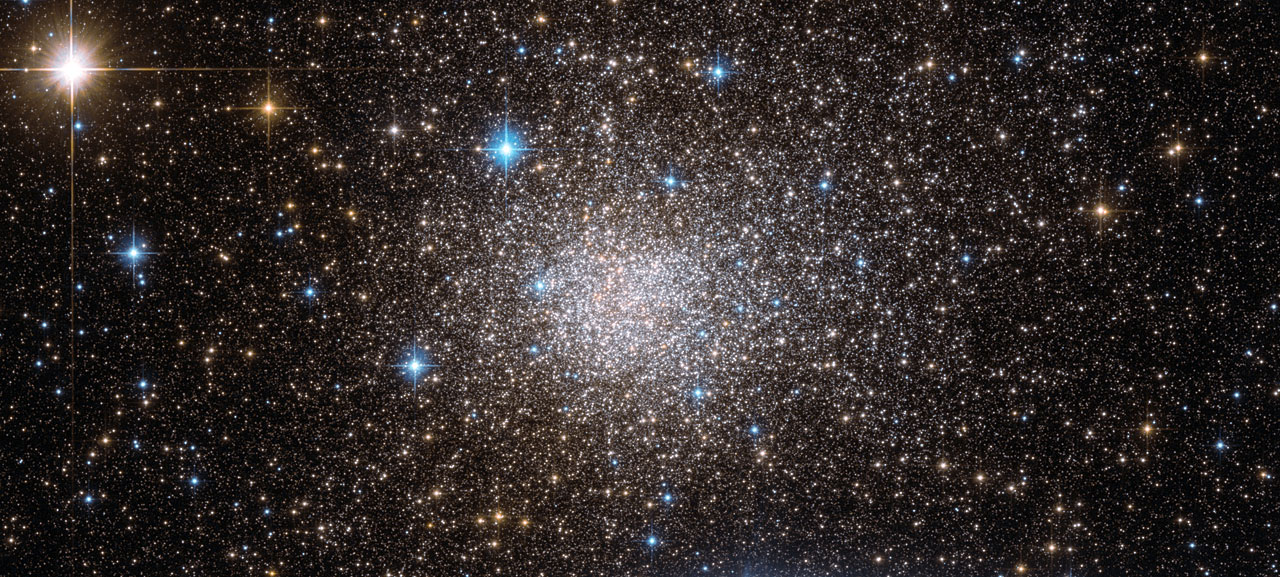Globular clusters are among the most spectacular of objects in the entire night sky. Compact balls of hundreds of thousands of stars, well over a hundred orbit our galaxy at various distances. When viewed by Hubble,
the result is nothing less than jaw-dropping:
[Click to embiggen, and please do; I had to crop the image to get it to fit and the full-size version is even more spectacular!]
This view of Terzan 5, as it’s called, is gorgeous! The thing is… Terzan 5 may not really be a globular cluster. Sure, it’s a cluster, and it’s globular, but it may not be what we usually think of as a globular cluster.
When I read the press release for the picture, the name Terzan 5 looked familiar. So I searched my blog, and found
I’ve written about this object before. That post was about a ground-based Very Large Telescope picture of the cluster,
seen here. The picture looks odd because Terzan 5 lies in a very crowded region of the Milky Way, lousy with dust. That interstellar junk tends to scatter away blue light, making objects look redder. The dust blankets across Terzan 5, but is thicker in one half than the other, making that side redder than the other.
Terzan 5 itself is also unusually dense, with stars packed in it more tightly than is usual for a globular cluster. Not only that, but studies have shown the stars in the cluster appear to fall into two different age groups; one significantly older than the other. That’s weird. In most clusters, the stars are all the same age, indicating the cluster formed all at once. Terzan 5 isn’t like that, so maybe it has a different birth story.
Astronomers think that the cluster may actually be the remains of a dwarf galaxy, one much smaller than ours, that got eaten by the Milky Way. Billions of years ago the two collided, and the gravity of our bigger galaxy stripped away many of the stars in Terzan 5. What was left over was this roughly spherically-shaped ball. The stars are different ages because some galaxies tend to form stars in bursts, making lots of stars, then not many, then lots of stars again as time goes on. That fits with what we see here.
So Terzan 5 is basically the undigested bits left over after a galactic cannibalism event.
The Hubble picture itself is pretty nifty, too. This is a little complicated, so bear with me. The image is false color: it’s a combination of two observations, one using a yellow filter (colored blue in the final shot here) and the other in the near infrared (colored red). The astronomers also simulated a third exposure by combining and processing the two observations to mimic what an observation through a green(ish) filter would have produced. By combining all three images, they get the results above. I don’t think creating that third quasi-green image produces much science, but it does make a pleasing picture.
It’s different than the VLT image; the striking difference in color across the VLT picture isn’t as obvious as in the Hubble picture. But if you look carefully you can see the streak of red stars going through the Hubble shot. The filters used and the way they were combined change the way we see the resulting image. And it’s more than just a pretty picture: in this case it helps understand how the stars are arranged in the cluster, and that provides clues to what happened to it in the past.
It’s not completely clear that Terzan 5 was once a galactic snack, it still may just be a very odd globular cluster. But by observing it using multiple telescopes in multiple ways we learn more about it, and hopefully will be able to unravel what happened all those eons ago to make this strange and lovely object.
Image Credits: NASA/ESA/Hubble; ESO/F. Ferraro



